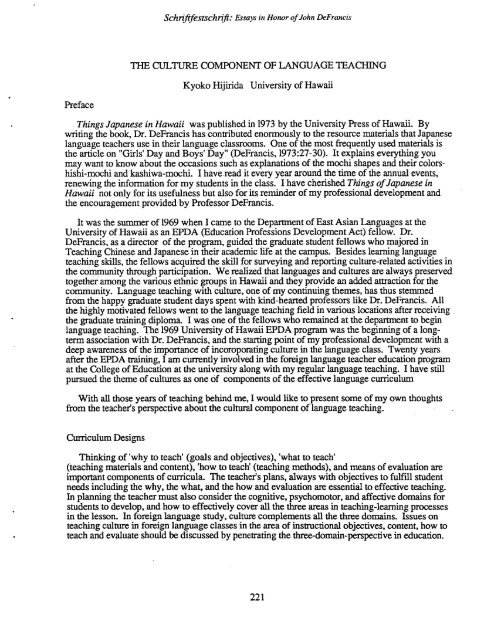Essays on Writing and Language in Honor - Sino-Platonic Papers
Essays on Writing and Language in Honor - Sino-Platonic Papers
Essays on Writing and Language in Honor - Sino-Platonic Papers
You also want an ePaper? Increase the reach of your titles
YUMPU automatically turns print PDFs into web optimized ePapers that Google loves.
Preface<br />
S~hnffestscch @: Ersays it; Homr of John DeFruncis<br />
THE CULTURE COMPONENT OF LANGUAGE TEACHING<br />
Kyoko Hijirida University of Hawaii<br />
Th<strong>in</strong>gs Japanese <strong>in</strong> Hawaii was published <strong>in</strong> 1973 by the University Press of Hawaii. By<br />
writ<strong>in</strong>g the book, Dr. DeFrancis has c<strong>on</strong> tibuted enormously to the resource materials that Japanese<br />
language teachers use <strong>in</strong> their language classrooms. One of the most frequently used materials is<br />
the article <strong>on</strong> "Girls' Day <strong>and</strong> Boys' Day" (DeFrancis, 1973:27-30). It expla<strong>in</strong>s everyth<strong>in</strong>g you<br />
may want to know about the occasi<strong>on</strong>s such as explanati<strong>on</strong>s of the mochi shapes <strong>and</strong> their colors-<br />
hishi-mochi <strong>and</strong> kashiwa-mochi. I haveread it every year around the time of the annual events,<br />
renew<strong>in</strong>g the <strong>in</strong>formati<strong>on</strong> for my students <strong>in</strong> the class. I have cherished Th<strong>in</strong>gs of Japanese <strong>in</strong><br />
Havaii not <strong>on</strong>ly for its usefulness but also for its rem<strong>in</strong>der of my professi<strong>on</strong>al development <strong>and</strong><br />
the encouragement provided by Professor DeFrancis.<br />
It was the summer of 1969 when I came to the Department of East Asian <strong>Language</strong>s at the<br />
University of Hawaii as an EPDA Educati<strong>on</strong> Professi<strong>on</strong>s Development Act) fellow. Dr.<br />
DeFrancis, as a director of the program, guided the graduate student fellows who majored <strong>in</strong><br />
Teach<strong>in</strong>g Ch<strong>in</strong>ese <strong>and</strong> Japanese <strong>in</strong> their academic life at the campus. Besides learn<strong>in</strong>g language<br />
teach<strong>in</strong>g skills, the fellows acquired the skill for survey<strong>in</strong>g <strong>and</strong> report<strong>in</strong>g culture-related activities <strong>in</strong><br />
the community through participati<strong>on</strong>. We realized that languages <strong>and</strong> cultures are always preserved<br />
together am<strong>on</strong>g the various ethnic groups <strong>in</strong> Hawaii <strong>and</strong> they provide an added attracti<strong>on</strong> for the<br />
community. <strong>Language</strong> teach<strong>in</strong>g with culture, <strong>on</strong>e of my c<strong>on</strong>t<strong>in</strong>u<strong>in</strong>g themes, has thus stemmed<br />
from the happy graduate student days spent with k<strong>in</strong>d-hearted professors like Dr. DeFrancis. All<br />
the highly motivated fellows went to the language teach<strong>in</strong>g field <strong>in</strong> various locati<strong>on</strong>s after receiv<strong>in</strong>g<br />
the graduate tra<strong>in</strong><strong>in</strong>g diploma. I was <strong>on</strong>e of the fellows who rema<strong>in</strong>ed at the department to beg<strong>in</strong><br />
language teach<strong>in</strong>g. The 1969 University of Hawaii EPDA program was the beg<strong>in</strong>n<strong>in</strong>g of a l<strong>on</strong>gterm<br />
associati<strong>on</strong> with Dr. DeFrancis, <strong>and</strong> the start<strong>in</strong>g po<strong>in</strong>t of my professi<strong>on</strong>al development with a<br />
deep awareness of the importance of <strong>in</strong>coroporat<strong>in</strong>g culture <strong>in</strong> the language class. Twenty years<br />
after the EPDA tra<strong>in</strong><strong>in</strong>g, I am cu~~ently <strong>in</strong>volved <strong>in</strong> the foreign language teacher educati<strong>on</strong> program<br />
at the College of Educati<strong>on</strong> at the university al<strong>on</strong>g with my regular language teach<strong>in</strong>g. I have still<br />
pursued the theme of cultures as <strong>on</strong>e of comp<strong>on</strong>ents of the effective language cllniculum<br />
With all those years of teach<strong>in</strong>g beh<strong>in</strong>d me, I would like to present some of my own thoughts<br />
from the teacher's perspective about the cultural comp<strong>on</strong>ent of language teach<strong>in</strong>g.<br />
Curriculum Designs<br />
Th<strong>in</strong>k<strong>in</strong>g of 'why to teach' (goals <strong>and</strong> objectives), 'what to teach'<br />
(teach<strong>in</strong>g materials <strong>and</strong> c<strong>on</strong>tent), 'how to teach' (teach<strong>in</strong>g methods), <strong>and</strong> means of evaluati<strong>on</strong> are<br />
important comp<strong>on</strong>ents of curricula. The teacher's plans, always with objectives to fuKill student<br />
needs <strong>in</strong>clud<strong>in</strong>g the why, the what, <strong>and</strong> the how <strong>and</strong> evaluati<strong>on</strong> are essential to effective teach<strong>in</strong>g.<br />
In plann<strong>in</strong>g the teacher must also c<strong>on</strong>sider the cognitive, psychomotor, <strong>and</strong> affective doma<strong>in</strong>s for<br />
students to develop, <strong>and</strong> how to effectively cover all the three areas <strong>in</strong> teach<strong>in</strong>g-learn<strong>in</strong>g processes<br />
<strong>in</strong> the less<strong>on</strong>. In foreign language study, culture complements all the three doma<strong>in</strong>s. Issues <strong>on</strong><br />
teach<strong>in</strong>g culture <strong>in</strong> foreign language classes <strong>in</strong> the area of <strong>in</strong>structi<strong>on</strong>al objectives, c<strong>on</strong>tent, how to<br />
teach <strong>and</strong> evaluate should be discussed by penetrat<strong>in</strong>g the threedoma<strong>in</strong>-perspective <strong>in</strong> educati<strong>on</strong>.

















